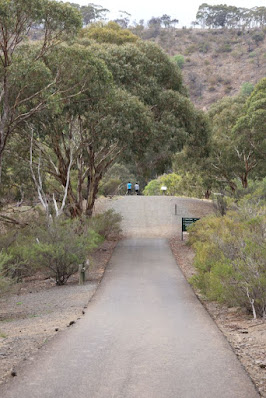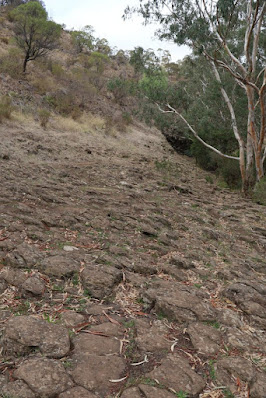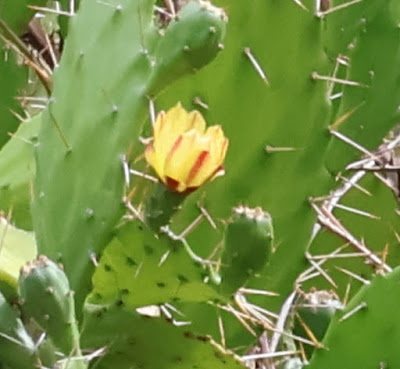Geology 10/10, maintenance not so much.
On 26 March we headed for Organ Pipes National Park. It is closer than the WTP, but in a rather different direction, near the airport. (I am reasonably sure that I have flown over this general area many times when flying in to Tullamarine.)
This is the eBird track of the walk we did - 2.6 km horizontal and (from Google Earth) about 80m vertical, although it felt a lot more on the way back.The landscape: the geology is all at the bottom along the creek.
The path down.
Basalt pipes: note the artistic reflection in the creek.
A wider view of the pipes.
I'm not sure if this counts as a pavement or not, but it appears that some folding has occurred and exposed the top of the pipes. But it is on a very steep slope rather than a flat area.
The second named feature is the Rosette Stone a little further along the creek.
A helpful sign.
Less helpful. No evidence of any work to fix up the issues and from the rustiness of the barriers this has been around for some time,
A wider view of the Rosette and its associated features.
The official tessellated pavement. Another set of pipes - with some prohibitory notice which we didn't bother going to read - above the far end.
Birding was OKish with nice views of a flock of Dusky Woodswallows (Bird of the Day) heading down to the Creek. I heard quite a lot of twittering - those well known taxa Hidden Songbird and Surreptitious Squeaker - but could see very little in the canopy against the polarised light.
This begins with the turn off from the freeway: an uncontrolled right turn across the city-bound carriageway of the 100kph limited M79. I would have thought that if VicRoads had the same definition of Motorway as anywhere else such turns would not be permitted. I'd be interested to know the accident rate in this area: the risk of getting t-boned must be quite high.
Surviving the turn one gets to the parking area with a well built Park HQ building. Closed and lots of very weathered notices stuck about. Some talked about revegetation work - there were lots of chook wire plant protectors by the creek but the survival rate of the plantings appeared to be about 0%. I would have said the area was totally unattended but as we left a woman in a Parks uniform appeared, picking up litter.
The Prickly Pears down by the Creek seemed to have a much higher higher survival rate ....
... and with flowering evident seem very likely to spread.
In contrast Parks have been able to acquire and install new seats. I wonder how many weeks of staff time are represented by this snazzy, brand new, seat near the un-maintained Rosette Rock viewing area.
Near the closed, and marginally (at best) maintained Park HQ there has been a lot of purchase of snazzy picnic tables. Gotta be a staff year or two in that lot.
... and with flowering evident seem very likely to spread.
In contrast Parks have been able to acquire and install new seats. I wonder how many weeks of staff time are represented by this snazzy, brand new, seat near the un-maintained Rosette Rock viewing area.
Near the closed, and marginally (at best) maintained Park HQ there has been a lot of purchase of snazzy picnic tables. Gotta be a staff year or two in that lot.
Overall our impression of the area is that the geology is extremely interesting but the lack of effort to maintain the environment is very poor. I suspect this is a manifestation of the Parks attitude, evident in other areas, that their role is to maintain/improve the installed asset base (eg tables and chairs) but to not have funds for revegetation, weed control and other environmental maintenance. I suspect that such functions have been delegated (without funding) to a Friends group.



















Comments
Post a Comment